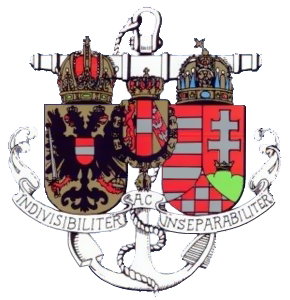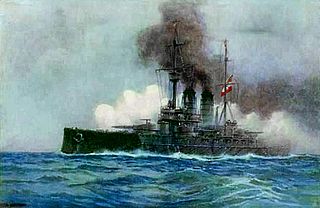
SMS Zrínyi was a Radetzky-class semi-dreadnought battleship (Schlachtschiff) of the Austro-Hungarian Navy, named for the Zrinski, a noble Croatian family. Zrínyi and her sisters, Erzherzog Franz Ferdinand and Radetzky, were the last pre-dreadnoughts built for the Austro-Hungarian Navy.

The Austro-Hungarian Navy or Imperial and Royal War Navy was the naval force of Austria-Hungary. Ships of the Austro-Hungarian Navy were designated SMS, for Seiner Majestät Schiff. Existing between 1867 and 1918, the k.u.k. Kriegsmarine came into being after the formation of Austria-Hungary in 1867, and ceased to exist upon the Empire's defeat and subsequent collapse at the end of World War I.
SMS Kaiser has been the name of two ships of the German Imperial Navy:

Kaiserliche Werft Wilhelmshaven was a German shipbuilding company in Wilhelmshaven, founded in 1871 and closed in 1918. Together with Kaiserliche Werft Danzig and Kaiserliche Werft Kiel it was one of three shipyards which solely produced warships for the Preußische Marine and the following German Kaiserliche Marine. With the end of World War I all three imperial shipyards were closed, but the Wilhelmshaven shipyard was reopened in 1919, first as Reichsmarinewerft Wilhelmshaven, and after 1935 named Kriegsmarinewerft Wilhelmshaven.

HMS Dryad was the name ship of the Dryad-class torpedo gunboats. She was launched at Chatham Dockyard on 22 November 1893, the first of the class to be completed. She served as a minesweeper during World War I and was broken up in 1920.

SMS Nautilus was a German minelaying cruiser built for the Kaiserliche Marine in the 1900s, the lead ship of the Nautilus class. The ship was built by AG Weser, with her keel laying taking place in December 1905. She was launched in August 1906 and commissioned in March 1907. Nautilus initially carried 186 naval mines and a battery of eight 8.8 cm (3.5 in) guns, but she was later modified to carry 205 mines and, in 1918, numerous light weapons to support amphibious operations.

SMS Radetzky was the first of the three Radetzky-class pre-dreadnought battleships built for the Austro-Hungarian Navy. She was named for the 19th century Austrian Field Marshal Joseph Radetzky von Radetz. Radetzky and her sisters, Erzherzog Franz Ferdinand and Zrínyi, were the last pre-dreadnoughts built by the Austro-Hungarian Navy—they were followed by the larger and significantly more powerful Tegetthoff-class dreadnoughts.

SMS Erzherzog Franz Ferdinand was an Austro-Hungarian Radetzky-class pre-dreadnought battleship commissioned into the Austro-Hungarian Navy on 5 June 1910. She was named after Archduke Franz Ferdinand. The first ship of her class to be built, she preceded Radetzky by more than six months. Her armament included four 30.5 cm (12 in) guns in two twin turrets, and eight 24 cm (9.4 in) guns in four twin turrets.
SMS Meteor may refer to one of the following ships:

SMS Albatross was a gunboat of the Imperial German Navy launched and commissioned in 1871. SMS Nautilus soon followed as her sister ship. She served as a gunboat overseas until she became a survey vessel in 1888. Struck from the list on 9 January 1899, she was sold and used as a collier until she foundered in a storm in March 1906.

A torpedo cruiser is a type of warship that is armed primarily with torpedoes. The major navies began building torpedo cruisers shortly after the invention of the locomotive Whitehead torpedo in the 1860s. The development of the torpedo gave rise to the Jeune École doctrine, which held that small warships armed with torpedoes could effectively and cheaply defeat much larger battleships. Torpedo cruisers fell out of favor in most of the great power navies in the 1890s, though many other navies continued to acquire them into the early 1900s.
Several warships of the German Kaiserliche Marine have been named SMS Wolf:
Three ships of the German and Austro-Hungarian navies have been named SMS Basilisk:
Three ships of the Imperial German Navy and one of the Austro-Hungarian Navy have been named SMS Möwe:
Several ships of the Prussian and Austrian/Austro-Hungarian Navies have been named SMS Drache (Dragon)
Several ships of the German and Austro-Hungarian Navies have been named SMS Greif
This page is based on this
Wikipedia article Text is available under the
CC BY-SA 4.0 license; additional terms may apply.
Images, videos and audio are available under their respective licenses.








